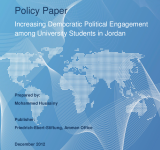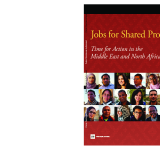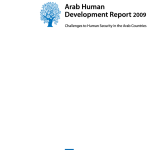intervention
The purpose of this paper is to examine the issues that are limiting the democratic perception of Jordanian university students' political engagement in university life. The paper defines this issue as being directly linked with both students' freedom and representative bodies. It offers a description of the historical and legal backgrounds associated with students' political participation in Jordanian universities;; and examines the core issues associated with students' political participation. This paper also categorizes the various problems that limit students' participation;; including intervention of security offices in student affairs;; the weakness of student clubs;; and the election mechanisms of student elections. This paper also discusses the absence of a student body that unifies various Jordanian universities;; disciplinary regulations;; university violence;; and the inability to students to express their political thoughts within the university.
Jobs are crucial for individual well-being. They provide a livelihood and;; equally important;; a sense of dignity. They are also crucial for collective well-being and economic growth. However;; the rules and the incentives that govern labor markets in MENA countries have led to inefficient and inequitable outcomes on the personal and collective standpoint. Several underlying distortions prevent a more productive use of human capital and have led to a widespread sense of unfairness and exclusion;; of which the Arab Spring was a powerful expression.
The fifth volume in the series of Arab Human Development Reports sponsored by the United Nations Development Programme and independently authored by intellectuals and scholars from Arab countries. The report argues that human security is a prerequisite for human development;; and that the widespread absence of human security in Arab countries undermines people's options.
يتضمن هذا التقرير تحليلاً موسعاً ومتكاملاً لمؤشرات الفقر بالاستناد الى بيانات مسح نفقات ودخل الأسرة لعام 2008;; الذي نفذته دائرة الاحصاءات العامة على أربع جولات ميدانية استمرت سنة;; والذي انتهى العمل به مع نهاية الربع الأول لعام 2009. وبناءاً على بيانات هذا المسح تم اعداد تقريرين سابقين: الأول كان فيه عرض للنتائج الرئيسية للمسح والآخر تناول قياس مؤشرات الفقر باستخدام منهجية السعرات الحرارية المعتمدة من قبل البنك الدولي ومقارنتها عبر الزمن بالأسعار الثابتة. وبناءاً عليه تم تم اعداد هذا التقرير التحليلي لحالة الفقر في الأردن;; وذلك بمشاركة العديد من الجهات الوطنية المعنية بالفقر. وكما يتناول التقرير تحليلاً للتدخلات الحكومية المباشرة بالأسعار الجارية خلال عام 2008 في الحد من ظاهرة الفقر.
يتضمن هذا التقرير تحليلاً موسعاً ومتكاملاً لمؤشرات الفقر بالاستناد إلى بيانات نفقات ودخل الأسرة لعام 2010 والذي بلغ حجم عينته 13866 أسرة ممثلة لكافة مناطق المملكة;; الذي نفذته دائرة الاحصاءات العامة على أربع جولات ميدانية استمرت لمدة عام وانتهت عام 2011. وجاء هذا التقرير ليتناول قياس مؤشرات الفقر باستخدام منهجية السعرات الحرارية المعتمدة من قبل البنك الدولي ومقارنتها عبر الزمن بالأسعار الثابتة. ويتضمن التقرير ثلاثة فصول: الأول يتناول منهجية قياس الفقر على مستوى المملكة والمحافظات وتحديد الأقضية الأشد فقراً;; أما الفصل الثاني فيتناول الجانب التحليلي لمسح نفقات ودخل الأسرة على مستوى الخمسينات;; وكما تناول هذا الفصل تحليل الجوانب الاجتماعية للأسرة الأردنية. فيما يتناول الفصل الثالث أثر التحويلات النقدية والتدخلات الحكومية وانعكاسة على ظاهرة الفقر والحد منها في عام 2010




